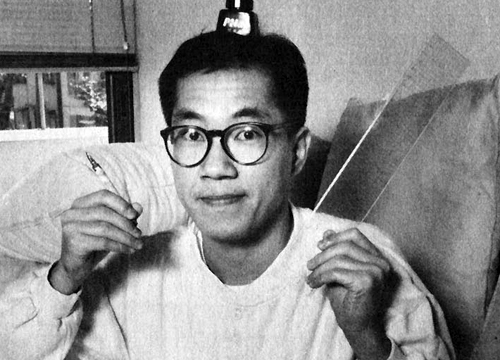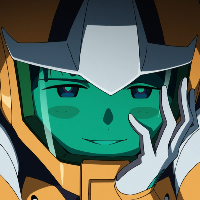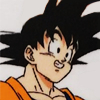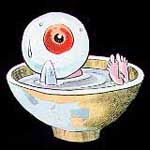The laziness vs. ambivalence thing is interesting. I think for his coloring -- just like the evolution of how he drew Goku from the beginning to the end -- just changed. If he wanted to color Bulma's hair purple or pink, he did what he felt. That's not necessarily laziness, despite him mentioning that he is indeed lazy and not that kind of referential of an artist.
One thing people don't realize is that there's no such thing as one color for, say, 'skin tone,' for instance. When you color something, you color to the mood of the piece. So if you're in a dark deep dank green cave, well, the hair might grab those greens... if you're in a bright blue sky, that hair's going to be a different color too. Mood seems to be what contributes to Toriyama's style more than anything else; what he feels is right at the time vs. on model.
The felt tip thing is interesting, which I find might be why the line thickness has changed a little bit. I assume the process you describe is close to how he drew the Kanzenban covers, since they were done around 2002 I believe? He probably did these pretty much exactly the way you said and this is an interesting look at his processes up through 2000.
I do think you guys should've touched on his coloring styles; there's some stuff in the first Daizenshuu where he talks about how his coloring processes changed from painting (I think?) to markers. You guys also didn't touch at all about how how shading style changed in general. I know I've said it before, but if you look at the early DB stuff, it's very much flat... lighter tones vs. the more dark, sharp, hard and contrasted shading of the Cell stuff which also mirrors his change to the more angular vs. round style. On shading alone, though, you can see how the Cell stuff has 2 or 3 layers of color on things like skin and clothing versus those very early promotional illustrations of Goku and Bulma that have a more soft watercolor look to them.
The other thing the digital art is missing is the paper textured that bleeds through on his old coloring techniques. If you look in the first Daizenshuu, you see a lot of paper texture bleed through which helps give a lot of art character. It's unique to every piece. A lot of the early Guilty Gear art is like this, too.
I think the main logical fallacy the whole podcast might cause people to assume, though, is that the way he drew in 2000 is how he draws now just because it's the last published report. That is probably NOT true. Artists, rather consciously or unconsciously always change. Even seasoned masters learn new things every day. Further, Digital art has grown exponentially since 2000. Photoshop barely had any kind of pressure support back in 2000, and Wacom tablets have grown in sensitivity. Now there's a million art tools to do art outside of Photoshop, even. At this point, he would probably be forced to change anyway, since Photoshop from back in 2000 probably wouldn't even run properly today, especially on PowerPC -> PC-Based Macs.
To give you an idea, the version of Photoshop back in 2000 was version _6.0_ Comparing Photoshop now to 6.0 is almost like comparing it to MS. Paint. I tried walking my friend who has 7.0 through masking techniques, and half of the tools aren't even there.
Looking at the DQIX art alone in high resolution, I cannot help but guess that he auto-vectors his lineart in Illustrator at this point. My assumption is that he draws on paper and then either inks or instead of inking, he drops it into the computer and auto-vectors it. The coloring is quite obviously photoshop, and it's very airbrushed, especially in the DQ stuff. I really wonder if he has a tablet at all or does it all by mouse. The problem isn't as much the linewidths -- which are thicker no matter how he inks -- but the bad tapering on the ends of lines. If he was just inking and scanning, the ends of lines would not just nub
out like this:
http://gamersblock.net/gamefluid/wp-con ... -Art-1.png
http://nationalpostarts.files.wordpress ... t-ix-1.png
The edges are just way too solid and perfect and digital.
Even if this was scanned from an inked drawing, he does some sort of technique to gives the edges some kind of solid edges and consistent color. Scanning inked drawings does not produce solid edges like that at 300 DPI, due to pen pressure and ink soaking into the paper. There is some process where he's likely converting scans into anti-aliased, completely black, digital lines, and just by looking at the bumps on the girl's shoulder, it probably auto-vectoring. You cannot get that clean and that solid of a line from a scan; there has to be some kind of tinkering done since ink bleeds into paper, and from the looks of things and, well, the lazyness factor that's been talking about, I'm figuring auto-vector.
Please excuse my inadequacies as an artist, I'm nowhere near as clean as Toriyama, but you can see here what I mean about paper texture (maybe even more)... I highlighted some of the cleaner strokes. Pen soaks into paper much the same way and flutters out.

Here is how ink affects paper:

Note I'm not saying this is all paper or all inks since there's tons of different paper and inks, but I hope you can at least see that scanning something like this... the edges and application of ink aren't going to be as perfect as the Dragon Quest stuff. He's doing something to anti-alias, solidify, and smooth out the edges almost certainly, which is probably why the ends of lines taper into balls. I figure he's either auto-vectoring or, maybe even weirdly, inking by mouse? I really hope not the second one.

I do wonder; these kinds of lines, especially here, where there's some bad erasure, bad aliasing artifacts, and just how the lines fit together at the end of the tunic, do not appear unless you're drawing or heavily meddling digitally.












